Scammonia, ScammonyDiagridium, Diagrydium (when prepared)Saqmunia (Unani) |

|

|
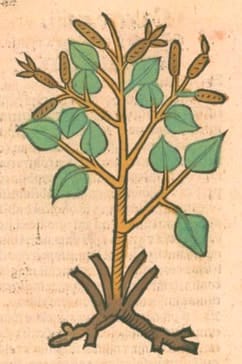 Ortus Sanitatis, Meydenbach, 1491
Ortus Sanitatis, Meydenbach, 1491
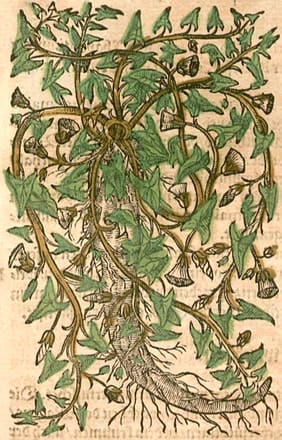 Krauterbuch, Lonitzer, 1578
Krauterbuch, Lonitzer, 1578 |
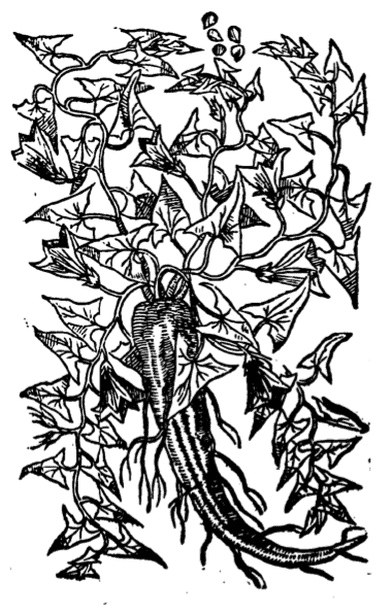 Parkinson, Theatrum Botanicum, 1640
Parkinson, Theatrum Botanicum, 1640 |
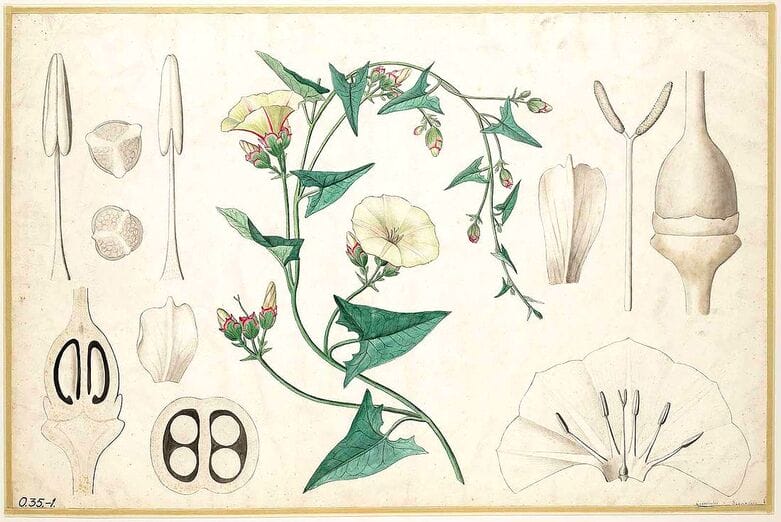 Botanische wandplaten (1904–1914)
Botanische wandplaten (1904–1914)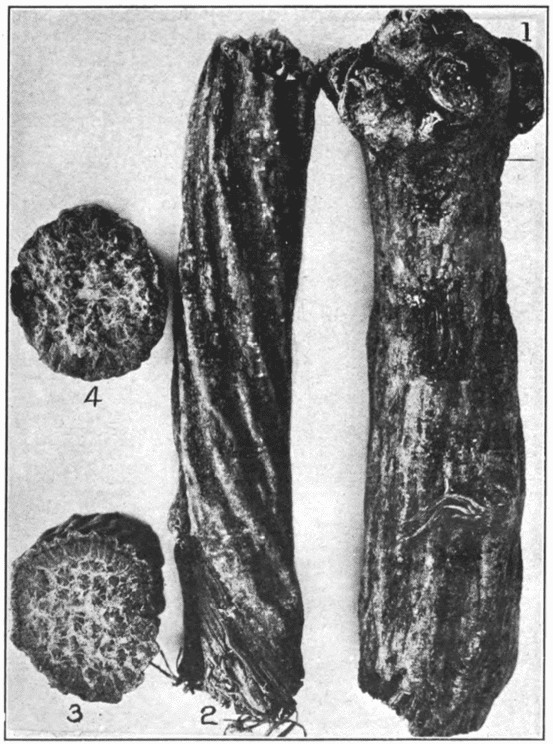 Scammony Root
Scammony Root1. Crown with stem scars and bases. 2. Twisted root with deep furrows.
3. Cross-section showing mottled surface. 4. Fractured surface.
Squibb’s Atlas of the Official Drugs, Mansfield, 1919
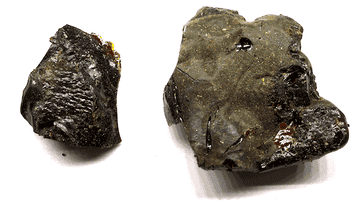 Scammony Resin
Scammony Resin(Calcutta Unani College, Adam, 2019)
Botanical name:
Convolvulus scammonia
Parts used:
Gum-Resin; Root
‘Scammony’ and ‘Diagrydium‘ actually refer to the dehydrated juice of the root which was the most used part. Good quality is light, clear like resin, grey, brittle, resinous, appearing greyish when powdered, a bitter taste, and unpleasant smell. The best quality came from Aleppo. Thick, heavy and very black is poorer quality, either being the juice of the whole plant, or adulterated.
Three main types were known:
- Aleppo Scammony: irregular masses, ash-grey colored, light with a bright fracture. Bitter, pungent taste
- Smyrna Scammony: more heavy, deeper color, more disagreeable odor (said to be from Periploca scammonea)
- Montpellier Scammony: entirely black, very hard and compact. (derived from Cynanchum monspeliacum in Spain and France)
Temperature & Taste:
Hot, dry. Pungent, Bitter. Toxic
“Scammony is hot and dry in the third degree but its hotness is more than its dryness”. (Avicenna)
Classifications:
2C INCIDERS. 2F. PURIFYING. 2K. RESOLVENT
Preparers and Purgers of Melancholy
Laxative, Purgatives and Cathartics
Uses:
1. Strongly Purges Bile and Phlegm, Passes Water:
-Hydrogogue Cathartic, passing water via the bowels
-purges principally Bile, also Phlegm and Water,
-used as a harsh cathartic; for water and fluid accumulations including Edema.
-purges Bile and all sharp humors.
2. Resists Poison:
-sometimes added to help purge obstinate toxic diseases
–“very useful against poisons of Scorpions”, used internally and topically. (Avicenna)
3. Kills Worms:
-Used for Broad worms by Celsus.
-used like this in Unani also, but the effects are not as strong as other anthelmintics. However, it is effective if combined with Turbith.
4. Externally:
-applied to chronic Headaches, mixed with Vinegar and Rose oil. (Avicenna)
-topically to Arthritis of the Hip, boiled with Vinegar and Barley flour.
-applied topically to Leprosy, Scabies and other obstinate skin diseases.
Dose:
1. “According to some physicians aged Scammony in smaller doses, proves to be a Diuretic without causing purgation”. (Avicenna)
2. Avicenna noted its action (strength) varies from place to place. That’s why some physicians prescribed larger doses.
3. ‘Scammony will act only feebly if at all when the patient is living in a cold climate, unless a large dose be administered’. (Avicenna)
4. “The best way of its use is to cook it with apple to be followed by mixing it with the water of celery. Then it becomes almost harmless”. (Avicenna)
Of Prepared Scammony in Pills: 125–325mg (traditionally 5–10 grains, equivalent to 325–650mg)
Always used in formula, so follow proportions of the formula.
Comment:
1. Scammony has been called one of the ‘Pillars of Physick‘, so important it was in the humoral-purging school of medicine. However, it must be used by experienced hands. For that reason, the only possible use of Scammony in the modern world would be in some of the elegant formulas of Mesue and Nicholas in particular where a small amount is added to an otherwise gentle formula which also tend to be well corrected.
Correctives:
1. Scammony is corrected by preparing with Quince juice; it maybe roasted in a quince, or heated in Quince juice and dried. Avicenna also said it can be roasted in an Apple.
2. Scammony is corrected with Licorice, Cloves, Ginger or Cinnamon (Salmon)
3. Myrobalans and Mastic also correct its harshness.
4. In Unani, Rose is regarded as corrective.
5. Aloes was often added to ‘temper’ Scammony, 2 drams of Aloes to 1 Scruple of Scammony. (This was first recommended by Pliny)
6. ‘The severity is, however, reduced by fifty percent when it is mixed up with the seeds of Celery’. (Avicenna)
7. ‘it can be corrected by decocting it with the water of Sour Quince, Apple or Rose’. (Avicenna)
8. Some said the best correction was to dissolve the Scammony in clarified Lemon juice in B.M., then strained while hot. This was said to remove the ‘gross and impure substance that does nothing but hurt’.
Preparation:
1. Quince Prepared Scammony:
Scammony is prepared by being boiled with Quince juice, or else placed inside a Quince or a green Apple, covered with a dough of wheat flour, dried, then baked until reddish-brown. When cool, the Quince is cut and the prepared Scammony is dried and kept for use.
Wirtzung (1598) had a more elaborate version. Two ounce of Scammony is powdered and mixed with a little Oil of Orris to form a paste. This is put into a hollow Quince and sealed with a piece of the Quince. It is then wrapped in dough and baked, and retrived from the Quince once cool. Then take 1 ounce of Yellow Myrobalan, steeped 24 hours in Quince juice on warm ashes. Press it very hard and mix the juice with the Scammony, and dry in a warm place. He notes that some add Mastic in the preparation.
2. Sulphuretted Scammony:
Scammony in powder, spread on white paper and keep over a chafing-dish containing burning charcoal; throw sulphur on the coals in small portions, stirring the Scammony til it begins to melt and adhere to the paper. (Dispensatorium medico pharmaceuticum Palatinatus, 1764)
3. Glycyrrhized Scammony:
Scammony (half pound), Decoction of Licorice (one pound). Triturate together, set aside, evaporate to dryness and powder the reside. (Pharmacopoeia Sardoa, 1773)
4. Rosated Scammony:
Scammony (half pound), Infusion of Rose (one pound). Triturate together, set aside, evaporate to dryness and powder the reside. (Pharmacopoeia Sardoa, 1773)
5. Cydoniated Scammony:
Scammony (half pound), depurated juice of Quince (one pound). Triturate together, set aside, evaporate to dryness and powder the reside. (Pharmacopoeia Sardoa, 1773)
6. A Preparation from Pomet:
Pomet (1748) gave a preparation of Scammony which he said could be be safely given to any person or constitution: Scammony, Turbith of each 4 oz., extract with Brandy, strain, and mix with 6 pounds of Syrup of Quince (that has not above 1 and a half pounds of sugar in it).
Substitutes:
1. Aloe and Colocynth are used as substitutes. (Unani)
2. Prepared Castor seed
3. Elder root bark was regarded as an acceptable substitute.
Main Combinations:
Usually combined with a greater proportion of Aloe (in a ratio of 6:1 or more)
1. Prepared Scammony with Aloe and Colocynth as in Lesser Pills of Cochia. This combination is used for Headache, Deafness, Tinnitus, Poor Eyesight, Cataract, Jaundice, Arthritis, Rheumatism, Lice, Worms, Premature Greying of Hair, etc.
2. To purge Phlegm, Prepared Scammony with Aloe, Agaric and Mastic (as in Pills of Isaac Heben)
3. Cold Phlegm and Damp of the Stomach and Spleen, Prepared Scammony with Turbith, Mace, Clove, Pepper, Ginger, Cinnamon, Greater Cardamon, Nutmeg (as in Indian Electuary Lesser of Mesue)
4. To Purge Melancholy:
i. Prepared Scammony with Dodder, Agaric and Polypody
ii. Prepared Scammony with Lapis Lazuli, Dodder, Polypody, Agaric, Black Hellebore, Clove, Aniseed (as in Pills of Lapis Lazuli)
5. To Purge Wind-Damp in Arthritis and Rheumatism:
i. Prepared Scammony with Elecampane, Costus, Ginger and Colchicum (as in Electuary of Clove and Costus)
ii. Prepared Scammony with Turbith, Colchicum, Senna, Elder flower (as in Powder for Arthritis of Turner)
iii. Prepared Scammony with Senna, Turbith, Sarcocolla, Rose, Mastic (as in Troches for Back and Sacral Pain)
6. To Purge Mixed Humors, Prepared Scammony with Turbith, Black Hellebore, Rhubarb, Agaric, Triphala, Ginger, Mastic (as in Infusion for Mixed Humors Compound)
7. Chronic Skin diseases, Eczema, Psoriasis etc:
i. Prepared Scammony with Aloe, Chebulic Myrobalan, Yellow Myrobalan, Black Myrobalan, Fumitory (as in Pills of Fumitory of Avicenna)
ii, Viper (Bai Hua She), prepared Scammony, Nux Vomica prepared, Pyrethrum, Saffron, Scorpion, Aloe, Frankincense (as in Qubaimaribairesi Pills of Uyghur Medicine)
Major Formulas:
Infusion for Mixed Humors Compound (Mesue)
Powder Purging Melancholy (Fuchs)
Electuary of the Juice of Roses (Mesue)
Indian Electuary Lesser (Mesue)
Electuary of Dates (Diaphoenicum) (Mesue)
Electuary of Polypody
Greater Polycrest Pills
Lesser Pills of Cochia
Pills of Fumitory (Avicenna)
Pills of Violet (Unani)
Cautions:
1. Caution must be taken in using these medicines. Severe intestinal irritation can follow even therapeutic doses. Death can result from overdose. It should never be used alone and should be used with Aloe, Rhubarb etc. in formula..
2. Not to be used in Pregnancy, by Children, the Aged, or in marked Weakness.
3. Never used in Heat and Inflammatory conditions of the Stomach or Intestines.
4. ‘Used immoderately and in time not convenient, it causeth swoonings, vomitings, and overturnings of the stomach… ’ (Gerard)
5. Taken frequently, it can produce hypokalemia, sodium depletion, and dehydration.
6. ‘Harmful for the Heart … Stomach and Liver’. (Avicenna)
7. Scammony should not be hot to taste; if it is, it was said to be adulterated with Spurge juice or Euphorbium.
Toxicity:
‘half dirham (1.75 gm), it would initially cause retention of fluids followed by pain, nausea and cold perspiration. Sometimes its purgative action is so severe that it becomes fatal.’ (Avicenna)
Antidote:
1. Barley water taken often
2. Syrup of Rose and Bugloss
3. Currants or their juice. (De venenis, Petrus, 1487)
4. Diascordium (De venenis, Ramesey, 1663)
Main Preparations used:
Prepared Scammony, Extract, Magistery, Scammony Sulphurated, Scammony Virtiolated, Syrup of Scammony (made by boiling with Sugar and Brandy).
1. Resin of Scammony:
i. Scammony powder (1 part), Alcohol 90% (6 parts). Dissolve, filter, distil off one part; precipitate the resin with adding water; wash it well and dry in a very gentle heat. (Dispensatorium Pharmaceuticum, 1777)
-
Extra Info
-
History
|
‘Scammony, also, is productive of derangement of the stomach. It carries off bile, and acts strongly as a purgative upon the bowels; unless, indeed, aloes are added, in the proportion of two drachma of aloes to two oboli of scammony. The drug thus called is the juice of a plant that is branchy from the root, and has unctuous, white, triangular, leaves, with a solid, moist root, of a nauseous flavour: it grows in rich white soils. About the period of the rising of the Dog-star, an excavation is made about the root, to let the juice collect: which done, it is dried in the sun and divided into tablets. The root itself, too, or the outer coat of it, is sometimes dried. The scammony most esteemed is that of Colophon, Mysia, and Priene. In appearance it ought to be smooth and shiny, and as much like bull glue as possible: it should present a fungous surface also, covered with minute holes; should melt with the greatest rapidity, have a powerful smell, and be sticky like gum. When touched with the tongue, it should give out a white milky liquid; it ought also to be |
extremely light, and to turn white when melted. ‘This last feature is recognized in the spurious scammony also, a compound of meal of fitches and juice of marine tithymalos, which is mostly imported from Judea, and is very apt to choke those who use it. The difference may be easily detected, however, by the taste, as tithymalos imparts a burning sensation to the tongue. To be fully efficacious, scammony should be two years old; before or after that age it is useless. It has been prescribed to be taken by itself also, in doses of four oboli, with hydromel and salt: but the most advantageous mode of using it is in combination with aloes, care being taken to drink honied wine the moment it begins to operate. The root, too, is boiled down in vinegar to the consistency of honey, and the decoction used as a liniment for leprosy. The head is also rubbed with this decoction, mixed with oil, for head-ache.’ (The Natural History of Pliny, trans. by Bostock and Riley, Vol. 5, 1856) |
From Pharmacographia, Fluckiger & Hanbury, 1879:
|
‘The dried milky juice of the scammony plant has been known as a medicine from very ancient times. Theophrastus in the 3rd century B.C. was acquainted with it; it was likewise familiar to Dioscorides, Pliny, Celsus, and Rufus of Ephesus, each of whom has given some account of the manner in which it was collected. Scammony used then also to be called Diagrydion, from the Greek word [?]: tear. The mediaeval Arabian physicians also knew scammony and the plant from which it is derived. The drug was used in Britain in the 10th and 11th centuries, and would appear to be one of the medicines recommended to King Alfred the Great, by Helias, patriarch of Jerusalem. It is repeatedly named in the medical writings in use prior to the Norman conquest (A.D. 1066), in one of which directions are given for |
recognizing the goodness of the drug by the white emulsion it produces when wetted. The botanists of the 16th and 17th centuries, as Brunfels, Gesner, Matthiolus, Dodonseus, and the Bauhins, described and figured the plant partly under the name of Scammonia syriaca. The collecting of the drug was well described by Russell, an English physician of Aleppo (1752), whose account is accompanied by an excellent figure representing the plant and the means of obtaining its juice. Scammony was formerly distinguished by the names Aleppo and Smyrna, the former sort being twice or thrice as costly as the latter; at the present day Aleppo scammony has quite lost its pre-eminence.’ |
